Charles Tucker
Family
Charles Tucker was born on 23rd October 1879 in Dartmouth, and baptised at St Petrox on 11th January 1880. He was the ninth child and youngest surviving son of Thomas Tucker, a Dartmouth pilot, and his wife Sarah Ann Pope. For more on the Tucker family, see the story of William Henry Tucker, Charles' elder brother, who joined the Royal Navy and lost his life in the Dardanelles when HMS Goliath was sunk on 13th May 1915. The family lived in Bayards Cove and Charles was recorded there with his parents and brothers and sisters in the 1881 and 1891 Censuses.
In November 1899, Charles joined the Post Office as a postman, working in Dartmouth and Kingswear, according to Post Office records. The Post Office was a close-knit community - also working there at that time was Alfred Brown, the father of Cecil Brown. When Alfred Brown died suddenly, leaving a wife and several young children, Postal Staff did what they could to raise funds to help the Brown family, and turned out in force at the funeral.
At the time of the 1901 Census, Charles was still living at home, with his father Thomas, now retired, his mother Sarah, and brothers Thomas, a labourer and Alfred, a plumber. Also at home was his youngest sister Lillian ("Lilly") who was partially blind. It seems, however, that he already had a sweetheart. In 1902, on 9th July, at the parish church in Chaldon Herring, Dorset, he married Georgina Pepperell, the eldest daughter of James Pepperell, coastguard officer, at the time based at White Nose (or White Nothe), near Ringstead. For more on the Pepperell family, see the story of Alfred John Pepperell, her younger brother. James Pepperell had been posted to Dartmouth in 1895 and his youngest child, Beatrice, was born in Dartmouth in 1897. Presumably Charles and Georgina first met during this period, and continued their relationship - presumably through the post - when the Pepperells moved to Dorset sometime before 1901.
Charles and Georgina's only daughter Doris May was born on 2nd November 1907. In the 1911 Census, the family was recorded at 2 Castle Cottages, South Town. Charles still worked for the Post Office, as a postman.
Service
Charles's service papers have not survived. However, the name "Chas. Tucker" was included in a list appearing in the Dartmouth Chronicle of 10th December 1915, of "Dartmouth men who have enlisted under the group system", and again in a similar list of 24th December 1915. These were men enlisting under the "Derby scheme" - officially, the "Group Scheme". For the background to this last phase of voluntary recruitment, see the story of Thomas Charles, also recruited under the scheme.
Men enlisting under the scheme could choose either to serve immediately, or to attest with an obligation to come if called up later on. Attested men were split into two categories, single and married, and each was subdivided into 23 groups according to age. The last day of registration for the scheme was 15th December 1915 - as Charles's name appears in the Chronicle of 10th December, he clearly came forward a little before the final deadline.
Men accepted for service and choosing to defer it were transferred into the Army Reserve and sent back home until they were called up. The youngest men were called up first - at the time the scheme was introduced, a commitment was made that the youngest married men would not be called up until all 23 age groups of single men were called up. But as fewer single men came forward under the Derby Scheme than the Government hoped, conscription of single men was introduced under the first Military Service Act on 27th January 1916. From that date, all unmarried or widowed British men, between the ages of 19 and 41, were deemed to have enlisted on 2nd March 1916. The last batch of single men (other than 18 year olds) were called up under the Derby Scheme in March, in parallel with the first men to be summoned under conscription.
But the recruiting returns were still insufficient to maintain the Army at the agreed size, or to provide replacements for the casualties expected in the summer offensive. Also, the level of exemptions was running high. As a result, March 1916 saw the call-up of younger married men under the Derby Scheme, leading to protests that this failed to honour the Government's previous commitment, and that such men should not be sent to the front when all the single men had not come forward. The Government's response was to introduce general conscription by extending the Military Service Act to married men, and lowering the starting age to 18, on 25th May 1916.
Charles was a member of the Devonshire Regiment at the time of his death. The Regiment's Medal Rolls show that he joined the 1st Battalion, and do not list any other unit. His service number was 26698; some indication of when he may have been mobilised may be derived from looking at men joining the Devonshire Regiment with close service numbers, for whom some service papers have survived. For example, numbers 26692 and 26697 were both mobilised on 13th June 1915. Further, Number 26692 was posted to the 1st Battalion of the Devonshire Regiment, although only the man's discharge papers have survived. These record that this individual arrived in France on 4th October 1916, but do not state how long he remained at the Base Depot, or when he joined the Battalion in the field.
The 1st Battalion, as a regular army Battalion, had been mobilised at the outbreak of war, going to France on 21st April 1914. They had fought at the Battle of the Aisne in 1914, at Ypres in 1915, and on the Somme in 1916. For their experiences to the Battle of Morval, on 25th September 1916, see the story of George Peters.
According to the Regimental Historian, "from the beginning of October till the spring offensive opened in April 1917, the Devons enjoyed relative quiet". That said, they were still undertaking regular tours in the front line, and sustaining casualties. See the story of Cyril Privett, killed in action on 30th January 1917. During this period, they were in the Cuinchy sector, where they remained until the middle of March.
Assuming that Charles was mobilised around the middle of June 1916, then he most probably arrived in France sometime during the latter part of 1916, and with the Battalion a few weeks later, after spending time at the Base Depot. The Battalion's War Diary records large numbers of reinforcements arriving during the period from October 1916 to February 1917. See the story of William Elliott Stone, who enlisted at the same time, was probably mobilised at about the same time, and may well have arrived with the Battalion at the same time.
The Battle of Arras: Attack on La Coulotte, 23rd April 1917
The 1st Battalion remained in billets at Raimbert, west of Bethune, until 7th April, when they began a two day march south towards Arras. The 5th Division was in reserve for the start of the Battle of Arras, so the Devons were not brought down to the area until close to the date of the initial attack. For the background to the Battle, and a brief account of the action on 9th April, see the story of Cyril Stafford. The Devons were held in readiness at Villers-au-Bois, but were not required.
From 14th - 19th April, they held the new front line east of the village of Givenchy-en-Gohelle, facing a heavily fortified German defensive line running from the Souchez river through the village of La Coulotte, south of Lens, to the village of Avion. They sustained fairly heavy casualties during this period, being in continuing contact with the enemy. On 19th April they were relieved from the front line, but four days later returned to the same area in the attack on La Coulotte, part of the subsidiary action launched by First Army, in support of the larger attack taking place to the east of Arras by Third Army. The 5th Division's attack went in at 4.45am on 23rd April and was a costly failure - it is described in the story of Alfred Charles Partridge, also lost the same day.
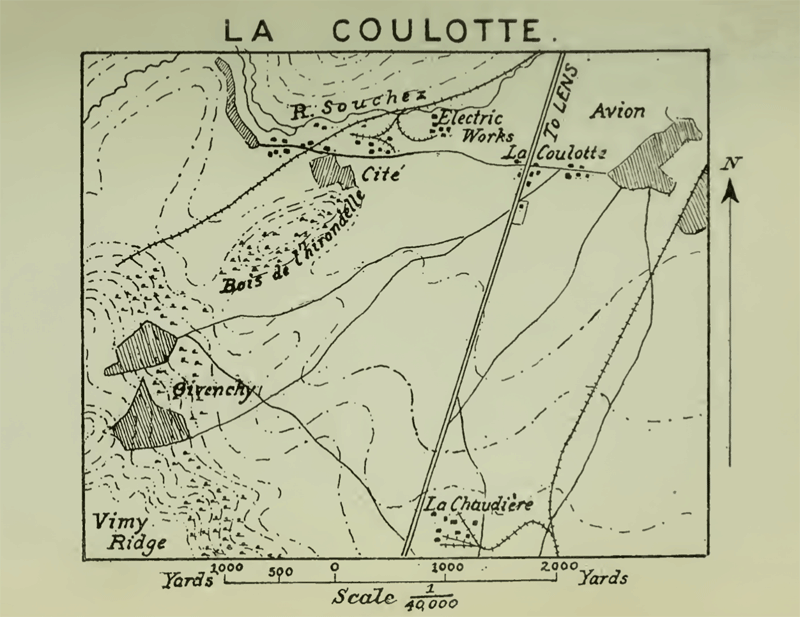
Death
Charles was one of those declared "missing" after the action on 23rd April 1917. On 9th June 1917, his name appeared in the Western Times of Devon Regiment men "missing". Although of course the list did not say so, the vast majority of those listed were from the 1st Battalion and subsequent records show them as having been killed in action (or presumed to have been so) on 23rd April 1917.
On Sunday 17th June 1917, a sad notice appeared in The People newspaper, in a column headed ""Tommies" Asked For - News Wanted by Relatives and Friends":
TUCKER 26698 Pte C Devon Regt - Wife inquires. Write Mrs C Tucker, Island House, Lower St, Dartmouth.
No news being forthcoming, Georgina placed a further notice in The People on 4th November 1917 in the same column:
TUCKER 26698 Pte C Devon Regt - Missing in France April 23 - Wife inquires - Write, Mrs C Tucker, 2 Castle Cottages, South Town, Dartmouth.
It seems that Charles' body was never found (or if it was, was never identified). The Soldiers' Effects Register records that he was "presumed dead" on 23rd April 1917 and the Medal Rolls similarly record "death regarded" 23rd April 1917.
Commemoration
Charles is commemorated in France on the Arras Memorial, which records the names of almost 35,000 men dying in the Arras sector between spring 1916 and early August 1918, who have no known grave.
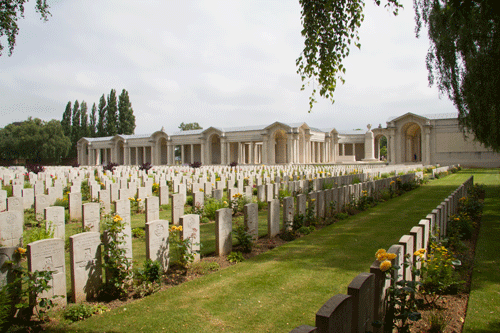
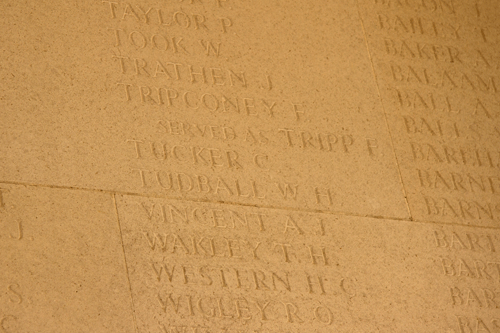
As one of the 579,206 casualties in the region of Nord-Pas-de-Calais, Charles is also commemorated on the new memorial at Notre Dame de Lorette, "The Ring of Memory".

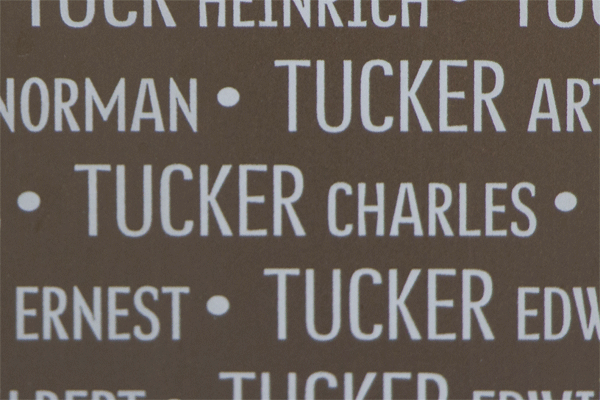
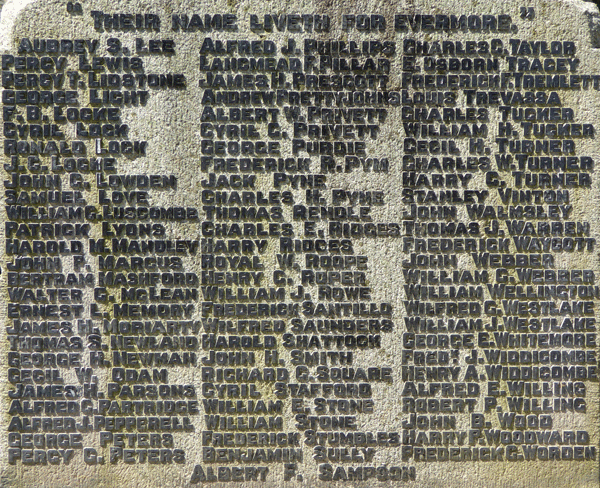
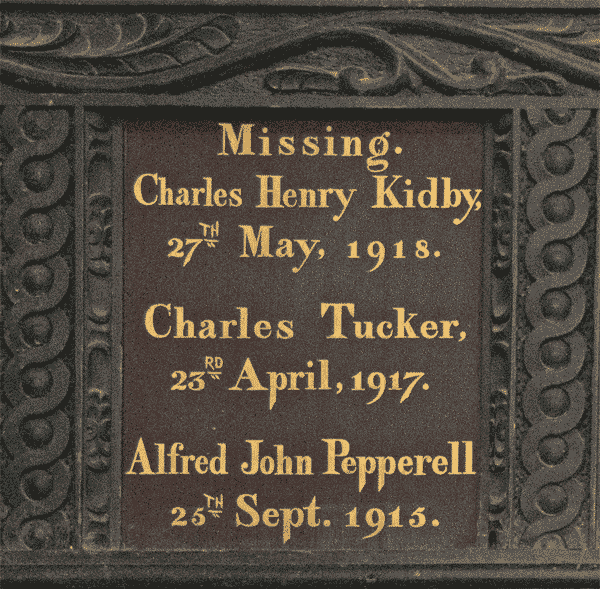
Note: One of the names appearing on the St Saviours Memorial Board is "J H Tucker". So far our research has not identified a Dartmouth casualty matching this name - it may be an error for Charles Tucker.
Sources
War Diary of the 1st Battalion Devonshire Regiment January 1916 - November 1917 available from the National Archives, fee payable for download, reference WO 95/1579/3
The Devonshire Regiment 1914-1918, compiled by C T Atkinson, publ. 1926, Exeter and London
The Fifth Division in the Great War, by Brig Gen A H Hussey CB CMG and Major D S Inman, publ. 1921, London, accessible online from archive.org
The Arras Offensive 9th April - 16th June 1917
The Battle of Arras: an Overview
Information Held on Database
| Surname: | Tucker |
| Forenames: | Charles |
| Rank: | Private |
| Service Number: | 26698 |
| Military Unit: | 1st Bn Devonshire Regiment |
| Date of Death: | 23 Apr 1917 |
| Age at Death: | 37 |
| Cause of Death: | Killed in action |
| Action Resulting in Death: | Battle of Arras |
| Place of Death: | Near La Coulotte, France |
| Place of Burial: | Commemorated Arras Memorial France |
| Born or Lived in Dartmouth? | Yes |
| On Dartmouth War Memorial? | Yes |
| On St Saviour's Memorials? | No |
| On St Petrox Memorials? | Yes |
| On Flavel Church Memorials? | No |
| In Longcross Cemetery? | No |
| In St Clement's Churchyard? | No |
| On a Private Memorial? | No |
| On Another Memorial? | Yes |
| Name of Other Memorial: | "The Ring of Memory" at Notre Dame de Lorette |















